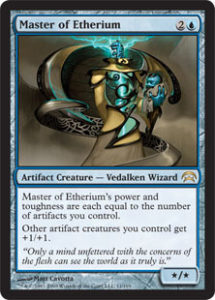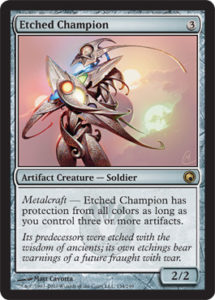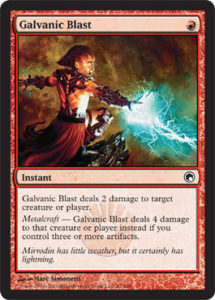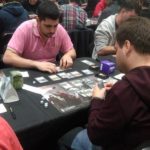The Affinity Aficionado – Understanding Affinity

Hello everyone! Today I’m going to talk about one of my favourite decks in modern, a variation of the first competitive deck I ever played… I’ve got a crash course in AFFINITY!
This name was given because of the ability “affinity for artifacts”, even if today there are no cards with that ability in the deck, the name, and concept of the deck, remain. The aim of the deck is to play cheap, synergistic artifacts, which in turn receive a boost when used in combination with the most powerful cards in the deck.
Affinity has often been considered as a ‘kid deck’ for a number of years because any inexperienced player could easily pick up affinity and win using it, while still not having a full understanding of all the interactions possible in the deck, but underneath the simple exterior lies a complex engine. There are a number of complex boardstates, difficult mulligans and very close decisions that must be overcome before you can truly master affinity. I want to focus in on some critical points you may face during a game and how to approach them in order to getting a better understanding of how the cogs turn in this deck.
1.- Deck construction.
Normally in this kind of super aggressive strategy you try to make your deck the most solid and consistent you can, playing 4 of each of the best spells you have access to. This is true with affinity, much of the deck is 4 ofs, and therefore many lists look 90% similar, but it is the fine tuning that can make all the difference. The mana base, the mana producers (Mox Opal, Springleaf Drum), the Cranial Plating and the core creatures (Arcbound Ravager, Ornithopter etc) are always going to stay the same. In order to get regular, explosive draws, you will need a consistent number of lands and cheap artifacts, this leaves you with space for only about 15 payoff cards, with the rest being necessary evils.
So, the main decisions when deckbuilding are going to be:


Your 3 drops: More specifically, the split between Master of Etherium and Etched Champion. This split is going to depend on what you expect to face. In a vacuum Master is a much better card in your deck, but the fact it requires blue mana is restrictive and it can easily be removed by pesky spells such as Path to Exile or a Fatal Push. Etched Champion looks like and 3 mana 2/2, and it is, but it has the potential to be so much more. When equipped with a plating Champion can become upwards of an 8/2 with protection from blockers and removal spells, it is your best tool against control decks. However, the current meta is dominated by aggressive decks, meaning presently Master is the better option main deck.


Your 5 removal spells / disruption: You want to keep this number low, in order to maintain a high artifact count, however there is still a wide mix of options for affinity players, so don’t worry! Most common in this spot are cards like Galvanic Blast, Welding Jar, Thoughtcast or previously Spellskites (to deal with pesky Splinter Twins). It is often hard to determine which of these is correct and often depends on the meta at the time, but I usually choose to either play blast or Thoughtcast, not a mix of the two, as usually one is better than the other at any given time, but that is up to you to decide individually.
2 – Mulligans.
The ideal hand should have 2 lands, 1-2 payoffs cards and the rest cheap, synergistic spells. It’s very common to see inexperienced players keeping hands where they can play the seven cards on turn 1 but without one of your more powerful cards, you need to find a balance. It’s better to keep a slow hand with threats rather than turn 1 play 3 Ornithopters, 1 Springleaf Drum, 1 Mox Opal and 1 Vault Skirge and do nothing. You are left with full board, that doesn’t pose any real threat to the opponent.
3 – Sequencing.
It’s very easy to lose because you miss a point of damage or because you play your spells in the wrong order, the fact that the deck can win very fast doesn’t mean that you have to play fast. Take your time and think about every move before you act. The deck has a lot of small interactions that can make all the difference, from sacrificing a drum to an Arcbound Ravager in order to deal 1 more damage on turn 3, to when to go all in or not. There are a lot of games where you need to sacrifice all of your permanents on turn three to make a 5/5 Inkmoth Nexus and win in two attacks. You learn all of this with experience, there is always something to learn in every match, so it’s very important to analyse each game and try to see if you could have played better in that game, even if you won. Last year in the semi-finals of GP Bologna, one affinity player lost because he miscounted with a Ravager and an Inkmoth dealt 9 poison counters when he thought it was lethal. Always make sure to count your Ravager math twice!

4 – Sideboarding.
Affinity is a deck that often loses to hate cards like Stony Silence or Shatterstorm. If either of these resolve it is almost impossible to win. To battle against such powerful anti-affinity cards, you need some disruption whilst ensuring you don’t dissolve your overall strategy. My rule is; never sideboard more than 5 cards with affinity, a good mix of discard spells like Thoughtseize, or counterspells like Stubborn Denial should do the trick. Personally, I prefer these over Wear // Tear due to greater flexibility and utility when they do not draw their hate cards.
In summary, I think this is one of the best decks in the format if you know what you’re doing and understand all the nuances of the deck. If I were to attend a Modern tournament this weekend, here is the list I would play, based on the current meta:
| 4 Arcbound Ravager |
| 4 Cranial Plating |
| 4 Darksteel Citadel |
| 3 Master of Etherium |
| 3 Galvanic Blast |
| 4 Inkmoth Nexus |
| 2 Etched Champion |
| 4 Blinkmoth Nexus |
| 4 Ornithopter |
| 4 Signal Pest |
| 4 Springleaf Drum |
| 4 Steel Overseer |
| 4 Vault Skirge |
| 2 Memnite |
| 4 Mox Opal |
| 3 Spire of Industry |
| 2 Welding Jar |
| 1 Mountain |
| 2 Ancient Grudge |
| 2 Ghirapur Aether Grid |
| 2 Etched Champion |
| 2 Thoughtseize |
| 1 Dispatch |
| 2 Relic of Progenitus |
| 2 Stubborn Denial |
| 2 Blood Moon
|
Thanks for reading, I hope you’ve enjoyed this article and learnt something too. Just make sure not to tell people that affinity is good, otherwise they might start adding more Stony Silence to their sideboards…





